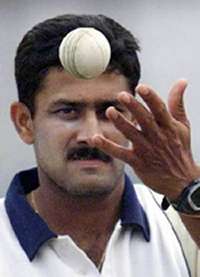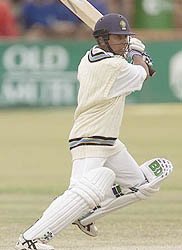Time to try out a few options
Having to win a Test to just keep the series alive is an unenviablesituation
Partab Ramchand
22-Aug-2002
Having to win a Test to just keep the series alive is an unenviable
situation. Invariably the pressure builds up. India find themselves in
exactly this position on the eve of the third Test against England at
Leeds. What compounds the depressing scenario is the fact that the
visitors do not appear to have the firepower in the bowling to draw
level in the series.
The onus will thus again be on the batsmen, and in this department,
the Indians are strong enough to more than hold their own and help
draw the game. But already being one down in the four-match rubber,
India will have to bowl England out twice to win, and if the totals
run up by the home team thus far are any evidence, then the bowlers
will be hard-put to bowl the side out even once.
 © Reuters |
Then there is the current batting strength. With a big total in the
kitty, even toothless attacks suddenly develop fangs. England is also
struggling with the bowling line-up, thanks to injuries, and as the
Indians proved at Nottingham, their attack too lacks firepower. There
is enough evidence to suggest that India's batting is as strong - if
not stronger - than England's. Given this background, if India bat
first and run up a huge total, they can put England under pressure.
But for that to happen, the bowling, with its limited resources, must
perform above its potential. But who should constitute the bowling
line-up? So far in the series, the Indians have gone in for three
seamers and one spinner, and it has got them nowhere. Has the time
come then for two seamers and two spinners? Neither Anil Kumble nor
Harbhajan Singh has covered himself with glory thus far in the series,
and the overseas record of the duo is anything but impressive. But
then again, what have the seamers achieved? Except for Zaheer Khan,
who has achieved some degree of consistency, neither Ajit Agarkar nor
Ashish Nehra has been particularly impressive. Agarkar in fact has
done well with the bat, but it must not be forgotten that he is in the
side primarily as a bowler, and if he is unable to perform that basic
duty, he should make way for others.
But who are the others? That is a moot point, for the team management
really has a Hobson's choice. The only combination that has not been
tried out in the series is two seamers and two spinners, so perhaps
the time has come to play both Kumble and Harbhajan. In late August in
England, there is a strong case to go in for a spin-oriented attack,
just as it is an ideal tactic to play as many seam bowlers as possible
in May-June. Surely the Indian attack cannot come in for any more
punishment than it was subjected to at Lord's and Trent Bridge.
Moreover, playing both Kumble and Harbhajan could be a surprise
tactic, for England may not expect the visitors to field two spinners.
As any army general could tell you, a surprise tactic could well catch
the enemy off guard and provide a decisive advantage.
But while there are problems and options aplenty as far as the bowling
is concerned, thankfully the batting strength is as intact as ever. It
may even be stronger with the inclusion of Shiv Sunder Das, who with
his monumental 250 at Chelmsford has surely won back his place in the
side. The diminutive opening batsman from Orissa just lacked a big
score to boost his confidence, and his marathon performance must have
given him a tremendous psychological boost.
 © CricInfo |
There is some talk about Sanjay Bangar being asked to partner Sehwag,
but there is an imperative need for playing the better batsman at the
top of the order, for that is one place where there is a problem.
Bangar is nowhere near Das as far as technique and temperament are
concerned, and with Sourav Ganguly to operate as an additional seamer,
he will also be rendered redundant as far as the bowling is concerned.